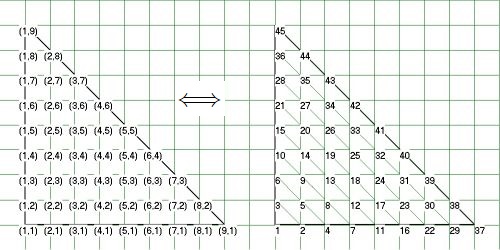

Poorman's option. I have tabulated, not "formulated" the values in the second picture.
It has been done for a grid that is such that the horizontal / vertical legs of our isosceles right triangle contains $n=9$ gridpoints.
Of course, we seek to generalize this for abitrary $n$.
What I need first is a formula or a short algorithm (preferrably a one-liner) that converts Grid coordinates into Triangle numbering.
Call this function $\,\operatorname{nr}(i,j)\,$, giving as shown in the pictures:
nr(1,1) = 1; nr(2,1) = 2; nr(1,2) = 3; nr(3,1) = 4; nr(2,2) = 5; nr(1,3) = 6; and so onAnd also the other way around, formulas or short algorithms that converts Triangle numbering into Grid coordinates. Call them $\,\operatorname{nr2i}(n)\,$ and $\,\operatorname{nr2j}(n)\,$. Examples as in the pictures:
nr2i(1) = 1; nr2j(1) = 1; nr2i(2) = 2; nr2j(2) = 1; nr2i(3) = 1; nr2j(3) = 2; and so onA hint may be that arithmetic sequences are involved with $\,\operatorname{nr}(i,j)$: $1+2+3+\cdots +n=n(n+1)/2\,$. And the sum $\,(i+j)\,$ is a constant for one green $\color{green}{\bf \mbox{\\}}$ "level".
EDIT.
Implementation of the answer given by cr001 has been done as follows. My favorite programming language is Pascal.
function nr(i,j : integer) : integer; begin nr := (((i+j-1)*(i+j)) div 2)-(i-1); end;Testing involves the fact that composing a function with its inverse reproduces identity:
function nr2i(n : integer) : integer; var h : integer; begin h := Trunc(1/2+sqrt(2*n))+1; nr2i := (((h-1)*h) div 2)-(n-1); end;
function nr2j(n : integer) : integer; var h : integer; begin h := Trunc(1/2+sqrt(2*n))+1; nr2j := h - nr2i(n); end;
n = nr(nr2i(n),nr2j(n)); i = nr2i(nr(i,j)); j = nr2j(nr(i,j));